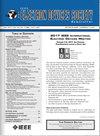凹槽结构V-NAND的保留特性和DMP效率
IF 2.4
3区 工程技术
Q3 ENGINEERING, ELECTRICAL & ELECTRONIC
引用次数: 0
摘要
在本文中,我们考虑相邻单元状态的影响,分析了具有凹槽(凸和凹)结构的垂直NAND(V-NAND)的保留特性。此外,我们评估了先前提出的假细胞程序(DMP)在改善保留特性方面的效率。结果表明,当相邻细胞处于擦除状态时,靶细胞的保留特性受到捕获电子引起的导带$(E_{C})$变化的影响。凹结构的保留性能最好,凸结构的退化最严重。当相邻细胞处于编程状态时,这种差异变得更加明显。然而,当DMP应用于表现出最退化的保留特性的凸结构时,由于快速编程速度引起的通道电位$(V_{ch})$的显著变化,观察到最大的改进。本文章由计算机程序翻译,如有差异,请以英文原文为准。
Retention Characteristics and DMP Efficiency in V-NAND With Dimple Structure
In this paper, we analyze the retention characteristics of vertical NAND(V-NAND) with dimpled (convex and concave) structures considering the impact of adjacent cell states. Additionally, we assess the efficiency of the previously proposed dummy cell program (DMP) in improving retention characteristics. Our results indicate that when the adjacent cell is in the erased state, the retention characteristics of the target cell are affected by conduction band $(E_{C})$ variations due to trapped electrons. The concave structure shows the best retention characteristics, whereas the convex structure shows the most degradation. This difference becomes even more pronounced when the adjacent cell is in the programmed state. However, when DMP is applied to the convex structure, which exhibits the most degraded retention characteristics, the greatest improvement is observed due to significant changes in channel potential $(V_{ch})$ caused by the fast-programming speed.
求助全文
通过发布文献求助,成功后即可免费获取论文全文。
去求助
来源期刊

IEEE Journal of the Electron Devices Society
Biochemistry, Genetics and Molecular Biology-Biotechnology
CiteScore
5.20
自引率
4.30%
发文量
124
审稿时长
9 weeks
期刊介绍:
The IEEE Journal of the Electron Devices Society (J-EDS) is an open-access, fully electronic scientific journal publishing papers ranging from fundamental to applied research that are scientifically rigorous and relevant to electron devices. The J-EDS publishes original and significant contributions relating to the theory, modelling, design, performance, and reliability of electron and ion integrated circuit devices and interconnects, involving insulators, metals, organic materials, micro-plasmas, semiconductors, quantum-effect structures, vacuum devices, and emerging materials with applications in bioelectronics, biomedical electronics, computation, communications, displays, microelectromechanics, imaging, micro-actuators, nanodevices, optoelectronics, photovoltaics, power IC''s, and micro-sensors. Tutorial and review papers on these subjects are, also, published. And, occasionally special issues with a collection of papers on particular areas in more depth and breadth are, also, published. J-EDS publishes all papers that are judged to be technically valid and original.
 求助内容:
求助内容: 应助结果提醒方式:
应助结果提醒方式:


